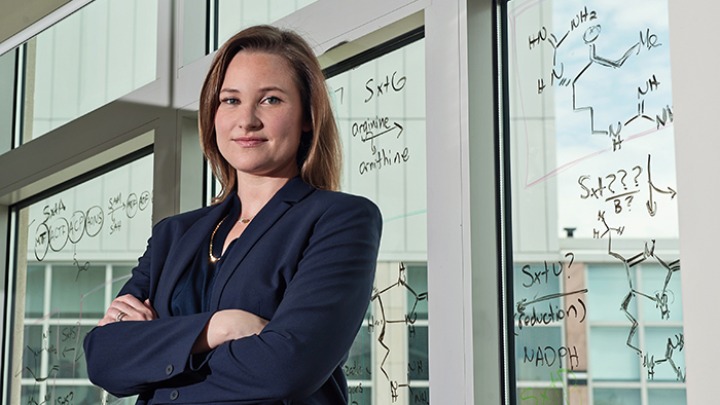
LSI faculty member Alison Narayan receives first Klatskin-Sutker Discovery Fund award
The Life Sciences Institute’s newest faculty member, Alison Narayan, Ph.D., is the first recipient of a Klatskin-Sutker Discovery Fund award, which will fuel the development of a library of bioactive molecules to support the search for new antibiotics, antivirals and anti-parasitic agents.
The award, which was made possible by a generous gift from the Klatskin and Sutker families, provides funding to kick-start collaborative research within the LSI that has the potential for a high impact on human health, and that would be unlikely to be funded through traditional grants. The award will be presented annually.
“We are excited by work like this that pushes the boundaries of science and might lead to breakthrough treatments for human health," says Deborah Klatskin.
“We are thrilled to have Dr. Narayan be our first award recipient," says Burton Sutker, M.D., who also serves on the LSI Leadership Council. "This is exactly the type of research we were hoping to promote with this discovery fund.”
Narayan plans to create a library of chemicals containing guanidine groups, a class of compounds with potential biological activity related to the nervous system and muscle control (examples include the common antiseptic chlorhexidine and the acid-reflux blocker cimetidine).
Guanidine-containing molecules can be produced by microorganisms and are currently used to treat muscle weakness associated with a rare autoimmune disease, Lambert–Eaton myasthenic syndrome (LEMS) — but they have the potential to help investigate and possibly treat other neuromuscular health problems like epilepsy, cardiac arrhythmias, central nervous system disorders and pain sensitivity.
Guanidine-containing compounds are notoriously difficult for chemists to make in the lab, and scientists have not yet assembled a collection to study and modify for other potential uses. Over the next year, Narayan plans to do just that.
“Nature is much savvier than the average synthetic chemist and has evolved enzymes specifically for the task of introducing guanidine groups onto various molecular scaffolds,” says Narayan, who is also an assistant professor of chemistry in the College of Literature, Science, and the Arts. “Our goal is to harness the power of these natural pathways to generate a library of guanidine-containing molecules that we can test for biological activity and to further develop as drugs.”
Once a first-generation library of guanidine-containing molecules has been created, the next step will be to conduct a high-throughput screen of the compounds to assess their biological activity — and from the hits, create a second-generation library with refined potential.
“This is a very exciting project,” says Roger D. Cone, Ph.D., the Mary Sue Coleman Director of the LSI. “Not only is it breaking new ground in an important area of human health and disease, it will add novel compounds to our drug discovery libraries, supporting research in our Center for Chemical Genomics and Center for Structural Biology.”
Narayan’s lab is currently working to elucidate the biosynthetic pathway that produces saxitoxin, the powerful, guanidine-containing neurotoxin famously associated with shellfish poisoning and produced by fresh water cyanobacteria and marine dinoflagellates. By mapping the chemical transformations that microorganisms use to create saxitoxin, Narayan’s group aims to streamline the production of saxitoxin variants with potential therapeutic applications.
Last year, Narayan was named one of Chemical & Engineering News’ Talented 12, a recognition of young chemical scientists who are pushing boundaries in their fields.


